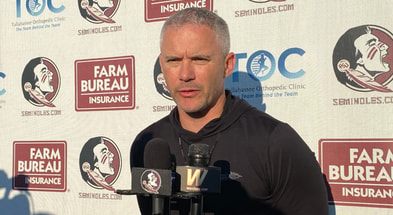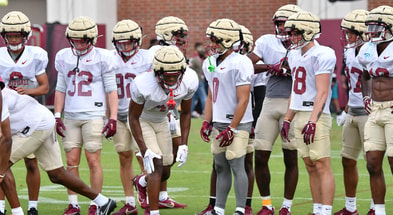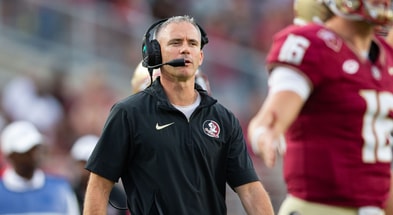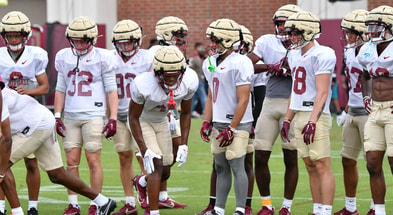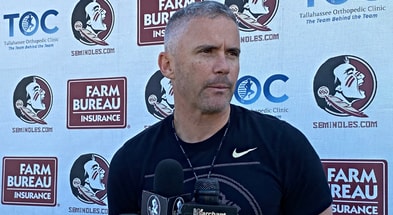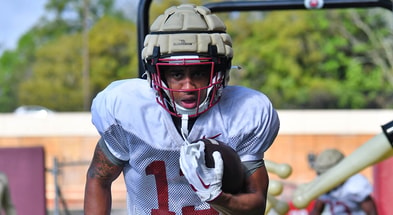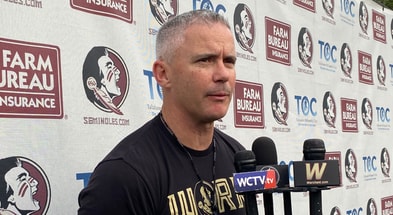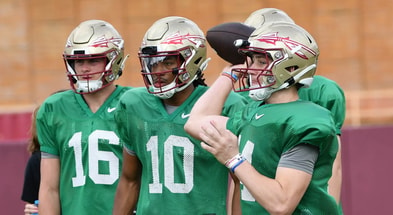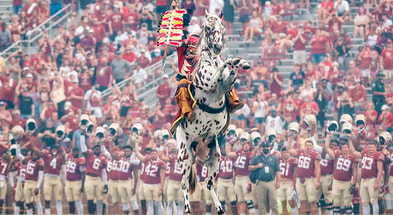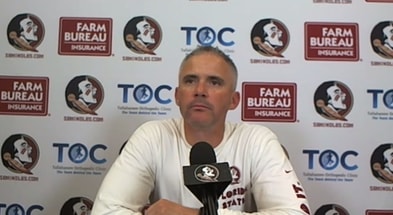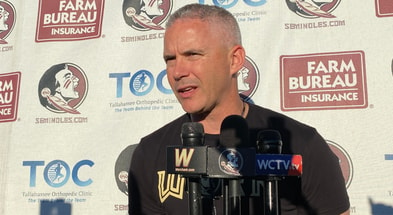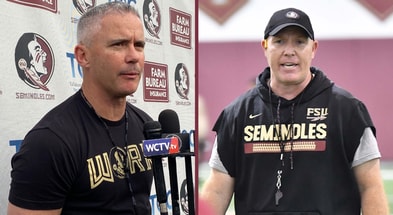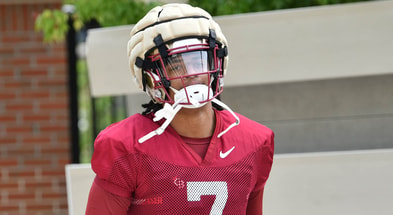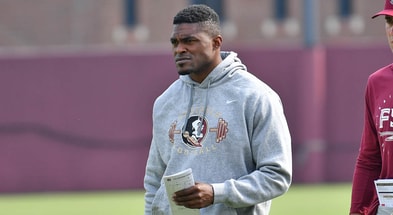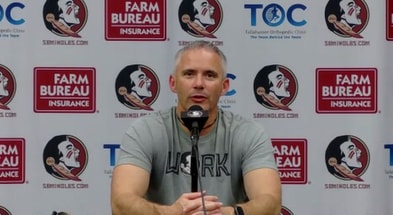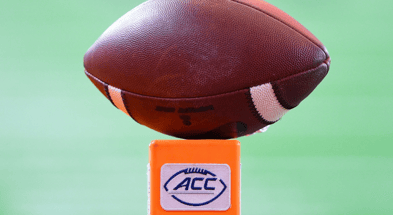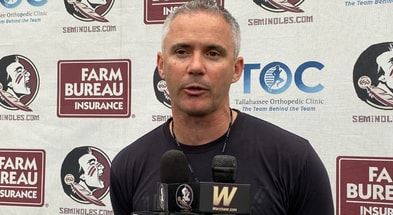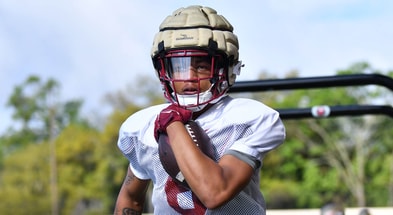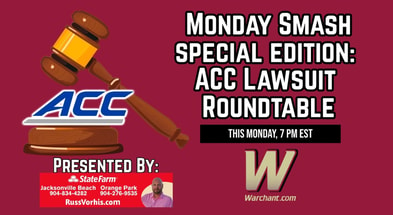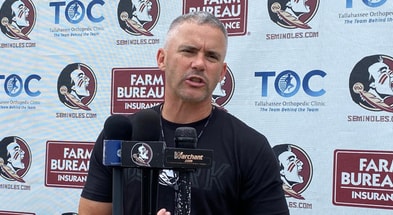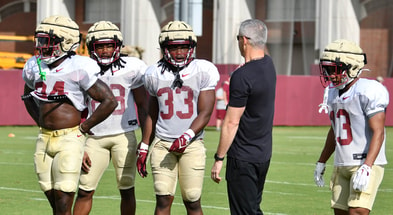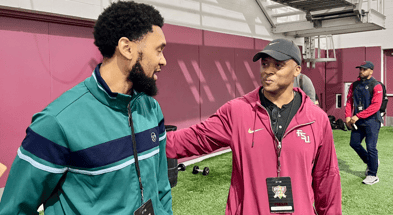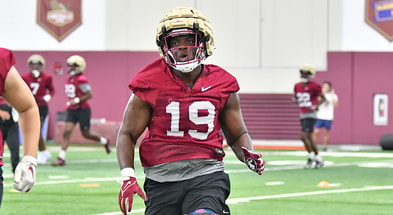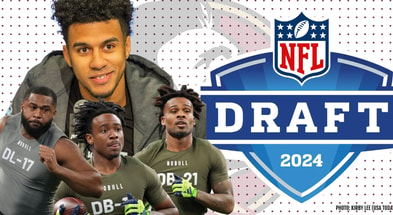One year on the job, FSU A.D. Michael Alford talks football investment, facilities, NIL and more
This week marks the one-year anniversary since Michael Alford started his tenure as vice president and athletics director at Florida State University.
During that time, Alford has worked with the university administration to devote more funding to the Seminoles’ football program, broken ground on a new football operations center, hired new head coaches in three sports, and helped each of Florida State’s 20 sports programs navigate NIL, the transfer portal and other changes to the national landscape.
While the FSU football team was in Orlando last week for the Cheez-It Bowl, Alford sat down with Warchant.com to discuss several of those topics and other developments from his first year in charge of the department. Here is a transcript of that conversation:
Q: Does it feel like you’ve been on the job longer than a year? It feels like that to me. I guess it’s because you were here in your role as president of Seminole Boosters for a couple years before that.
A: I count everything in football seasons (laughing). So I say three years, but it hasn’t been. It’s been 2 1/2 years really. But, you know, time flies. Time also goes fast because I think we’ve gotten a lot accomplished in the 2 1/2 years that we’ve been here. Starting on the Boosters side, changing the processes and some procedures, and putting some things in place. And having success, and then coming over as athletic director — pretty much the same changes in processes and procedures — and then kind of leaning forward a little bit more to make sure we get things accomplished. Holding people accountable to accomplishments. I think that’s something that makes the time go by a lot quicker.
Q: It hasn’t been talked about a lot publicly, but you’ve been able to bring in some new faces at the highest levels of your administration, with the hiring of Janeen Lalik as deputy athletics director for external operations and Lisa Varytimidis as senior associate athletics director/senior woman administrator. How has that gone? What have they brought to the department?
A: Two great hires. What Lisa Varytimidis and Janeen Lalik have brought on board is not only their expertise, but just their culture and personalities and how they fit with what we’re trying to get accomplished. And their vision for their roles matches what my vision is for those departments. And they’re both really pushing people to get better every day and challenging people to maybe do things — or look at things — a different way and to keep growing. And that’s something that I really admire in both of them, is they have big plans of their own that mirror the accomplishments that I want to see out of our department. And they’re pushing the needle a little bit.
*** Sign up for one year of premium access to Warchant.com and the On3 Network for only $10. ***
Q: How has the year gone in terms of the staff adjusting to some new ways of doing things?
A: Change is uneasy on everyone. But you need to accept it. Because we are going to look at different ways of doing things, or maybe ask questions about why we’ve done things a certain way. We’re looking for new ideas, and that’s something I challenge all of our departments to do: Continuously looking at ways to do what we’ve done and had success, but how do we make it better? And maybe mirror what other people are doing. You don’t need to reinvent the wheel. Maybe just change a spoke and do it the Florida State way — we’re constantly trying to just find ways to improve ourselves. That goes back to improving Boosters, marketing, improving the fan experience, improving our sports programs — whether it’s facilities, whether it’s nutrition, whether it’s The Figg and our plans on the dining hall. What are we doing for the student-athlete experience and the fan experience that keeps pushing the needle?
Q: When we spoke shortly after you took this job, you talked about the increased resources you and the administration were going to provide for Mike Norvell — in terms of salaries for additional support staff and other areas with football. How gratifying is it to see some returns on that investment so quickly?
A: Well, you have to pay attention to all the sports, but with that one — when you look at the history, we went back and looked at 10 years of making a commitment to that program. We were dead last in the ACC in terms of our percentage of commitment to football. That’s not Florida State. You look back and say, “OK, why are we in the position we are in?” And look at the analytics of it. That’s one of the reasons. There were a lot of other reasons, but one of them was we hadn’t made that commitment to that sport. And so giving them additional resources for staffing that’s needed to compete in today’s college football environment, and making sure we address facility needs.
To this day, I think we’re ninth in square-footage dedicated to football space in the ACC — not in the country, the ACC. So that’s getting addressed with the new football facility. But making sure that our brand in the sport of football is resourced properly to have success. I’m a firm believer that you can’t ask someone to have success if you’re not gonna give them the tools and the resources to accomplish their goals. So we’re constantly investing in it and we’ll continue to invest.
Q: One of the areas you increased in terms of staffing is the scouting department. Do you think that has been one of the reasons Coach Norvell has had so much success with identifying and recruiting players from the transfer portal?
A: One hundred percent. I think there are a lot of different things that have led to that success, but I mean, we’ve invested in personnel. And that personnel has been able to go out and evaluate talent — more importantly evaluate the right character of talent that’s coming in and adding to the culture that he’s established in such a short time. They’re getting the right people, and Mike uses the term, the “right fit.” And that’s 100 percent correct. The people that are coming into the program mirror the culture and the work ethic of the current students that we have involved in the program. So I definitely believe that because of the additional personnel, we’ve been able to do the proper evaluations and make sure that we’re making the right decisions on the people that we bring in.
Q: Speaking of the transfer portal, a lot of people — both fans and the media — are asking whether using it as much as Florida State has been using it is sustainable over the long term. Do you have any thoughts on that?
A: I think it’s gonna vary class by class. What the talent of the high school student-athlete is compared to what’s available in the portal. Whether it’s a high school student-athlete or a transfer, if you have the fit and the ability to upgrade a position, you’re going to do it. I don’t think you’re always going to live as much in the portal as we have, but with the changeover of a roster, it gives you the opportunity to get experienced players that can have an immediate impact. Whereas a high school student-athlete might take a year or two to make a difference. So it’s being able to adjust. I think we’re always going to go after high school talent, but if there’s someone in the portal who can make an immediate impact, we want to take them.
Q: How impressed have you been with the types of players Norvell and his staff are bringing in for visits — both from the portal and from high schools? I know you get to meet with many of them. It just seems like they’re almost always really sharp kids with some maturity about them.
A: Yeah, I think it goes back to what he says about the right fit. And I love sitting down when they’re on their official visits and visiting with the families of the young men that he’s bringing in. The one thing I hear from every mother, every father, the people associated with the student-athletes is that they’ve noticed a difference in the culture here than where else they’ve been and visited. We’re developing a culture that we really, truly care for the student-athlete experience. I was talking this morning to a coach about how it’s a big adjustment, whether it’s someone from the portal or a high school kid, coming to a Division-I Power Five program at this elite level. I mean, you’re walking in and facing some grown men in the room. That have been through the weight room, that have been through the process. So it’s an adjustment, and some handle it better than others. But the culture is going to stay the same.
And we’re going to care for the student-athlete experience and we’re going to be transparent with them, and what you see is what you get, for lack of a better term. But we’re going to have deep relationships and really care about them off the field. That makes a difference. They see that — the parents that come on these visits — that’s one thing they notice. We’re authentic with them.
Q: Having won some big games this season against big-name programs, do you get the sense when you talk to people in the industry that they’re taking notice of what Florida State is doing? That the football program is trending back in the right direction?
A: They’re definitely noticing. My peers in the industry, they notice what we’ve done to change the culture. They talk about the facility investment, they talk about the investments in the program that you mentioned earlier, and they look at what we’re doing on the field. And they see a bright future. It’s kind of like, “Dang it, that sleeping dog is waking up (laughing).” They see that. And we’ve just got to keep investing — that’s one thing you’re always going to see, and Mike and I talk about it all the time. We’re constantly going to be leaning forward. Because that’s what we need to do to constantly have success, and it’s never gonna get lackadaisical. So, that lean forward is going to continue.
Q: Because you’re still just catching up in terms of facilities, right?
A: We’re definitely still catching up. We were able to do some things nutritionally, for all of our student-athletes this year, that’s made a big plus, and I’m going to constantly get feedback from our student-athletes and coaches: “What do you need to be the best?” You know, we’ve resourced all of our programs very high within our conference, but that comes with accountability. We want to finish high to match the operational resources we’re providing, but you’re constantly looking to how you can tweak all of our programs to get the best out of those programs. Constantly keeping an eye out to make sure that we’re doing the right things in the training room — their health and well-being is our first concern. The student-athlete experience and their health and well-being is always top of mind.
Q: Link Jarrett was your highest-profile hire so far, and he hasn’t gotten to start his first season yet. But you also hired Brian Pensky in soccer and Brooke Wyckoff for women’s basketball, and they’ve obviously gotten off to great starts. I’m guessing you couldn’t have asked for much more with each of those so far.
A: Well, they fit our culture. And I’m always going to hire coaches of extremely high character. I have a method that I go about when hiring coaches, and it’s always going to be important because the student-athlete is so impacted by that individual during their time here. I mean, I still talk to my college coach; he has had a lasting impact on me. You talk to anyone who played for Coach [Bobby] Bowden, you talk to anyone played for Lonni [Alameda] … you’ve got to understand the impact of a coach on a program and student-athletes. So you’ve got to make sure you’re hiring people of high character that treat student-athletes the proper way, but also someone who’s gonna fit our culture.
I mean, Brian Pensky coming out the other day to the groundbreaking for the football facility. He’s involved. Link’s at events. Feeling that culture amongst all of our coaches is something I’m really proud of. When I hire a new coach and having the head coaches all come to the press conference … that goes a long way in developing the relationship and communication that we have amongst our staff.
Q: That’s not the case at all schools? Did coaches sort of stay in their own silos at other schools you’ve been around?
A: It’s something we stress. It’s a priority of mine, as athletic director, to develop a culture, and we’re not there yet. But there’s nothing that makes me more proud than when I go to a soccer game or a softball game, and seeing Jordan Travis. Or seeing Camm McDonald. Seeing our women’s basketball team attend soccer games. That community feel … they feel that. They feel that sense of community, that sense of family that we’ve established.
Q: It has obviously been a rough start to the season for men’s basketball, but Leonard Hamilton has such a great track record, and they seem to be playing better as of late.
A: Young team. Playing better, and they’re about to get Baba [Miller] on the court. Leonard is a Hall-of-Famer for a reason. And he’s doing the right things with a young team right now. And the future’s bright in that program as well, but we’re just going through a little hard-knocks year. But when you go to the practices, you see the respect they have for each other. You see them growing on the court. And you see where the future is heading — that program’s in good hands.
Q: Switching gears to the national landscape of college athletics, do you think there will be significant change at some point with NIL?
A: It’s got to. When I worked with the NCAA three years ago on this, before I was even at Florida State, we worked on putting in the guardrails and [establishing] the fair-market value … and them taking a pass on it. I go to D.C. a lot. I’m still working on it nationally. Still talking to senators. You know, we’ve got to be proud of the legislators we have — Gus [Bilirakis] in Tampa, Senator [Marco] Rubio and Byron Donalds. Those guys have taken this and are really doing a lot in D.C. Probably more than any state that I’ve seen. They’ve made it a priority. And they need to fix it. I hate to say it, but they need to save us from ourselves at some point. But I see it coming, and you already see the market correcting itself a little bit. And I knew that would happen after a year or so — you would see the market kind of correcting itself. And I’m all for NIL. But I’m also for utilizing the tools we have for measuring fair-market value, and everything that comes with that
Q: And I just want to touch on a few other topics that people have asked me about recently. With the football facility, I know the plans have changed somewhat through the years and costs have gotten higher because of materials and labor. Are you still going to be able to do everything you hoped it would be?
A: Yes. 100 percent. We’re still tweaking a little bit of it on the inside walls. But we’ll get there. We’re really close to the finished product; waiting on some bid packages to come back, and we probably will make a few minor adjustments once we get those back. But the impact it’s going to have — and I say it and I stress it — on all of our programs. It’s going to have a dramatic impact on football, but what you’re not going to see is the dramatic impact that it has on other programs now that the Moore Center is freed up. Everything from training room times to schedules and everything, it’s going to have as much of an impact on the 19 other sports that utilize the Moore Center.
Q: I know many of the sports have to work their schedules in the weight room around football. So football will have their own weight room in the new facility, right?
A: Yes sir. And some already had their own. Baseball has one at their facility, basketball has their own at their facility. But really, the weight room, training room times, and what we’re able to do now to expand our academic footprint by going into where football space is now and kind of utilizing that to expand our academic services, it’s gonna be huge.
Q: And then how is the first year of pre-selling going for the new suites and seating options that will be available when you look to renovate Doak Campbell Stadium?
A: Oh, unbelievable. I think we’ve raised $45 million in commitments right now. We’re about to hit another phase here at the start of the year on the club seating impact, and having those conversations at the preview center. So the next phase is about to kick off at the beginning of the year. But so far, when we’ve walked people through and shown them and explained to them where we are in the country — where we’ve been and where we want to go — people understand it. And we’re really excited to do that because as I’ve mentioned, when you look at the stadium, we haven’t adjusted the stadium. In the ACC, we’re eighth in the last 20 years when it comes to making a financial commitment to our stadium — in our own conference, again. And we’re $13 million behind the average SEC school in stadium revenues, and $9 million behind the average Big Ten school in stadium revenues. So how we can close the revenue gap is by addressing some things internally that we can address.
Q: Is there a timeline for when you are hoping to see the Doak renovations take place?
A: Right now, we’re shooting for the ’25 season. They tell me they can do it. Right now, they tell me everything we’re doing, we could be ready for the ’25 season. Now, you may have to enter with a hard hat on to get into the stadium (laughing) in some places. There will still be some construction, but we’ll be able to have the inner bowl and utilize the spaces for the ’25 season. Right now. But we’re still working through that.
Talk about this story with other die-hard FSU football fans on the Tribal Council.
